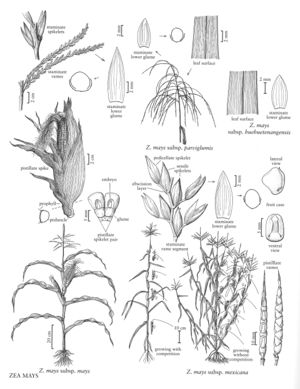Zea mays subsp. huehuetenangensis
Zea mays subsp. huehuetenangensis morphologically similar to subsp. parviglumis (see below), but it often grows more than 5 m tall, and has essentially glabrous leaves, and smaller staminate panicles with fewer (less than 40), firmer branches, and different ecological, phenological, and molecular characteristics.
Discussion
It is endemic to the Province of Huehuetenango, Guatemala, where it grows as a common weed on the edges of, and in, maize fields, and in seasonally moist oak cloud and tropical deciduous forests, at elevations from 900-1650 m. In its native range, it commonly hybridizes with Z. mays subsp. mays, both subspecies flowering from mid-December to mid-January, at the end of the wet season.
Selected References
None.
Lower Taxa
"decumbent" is not a number."thin" is not a number.
